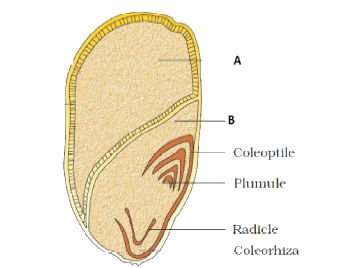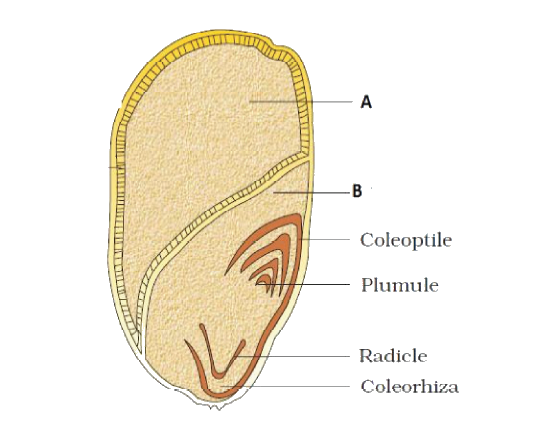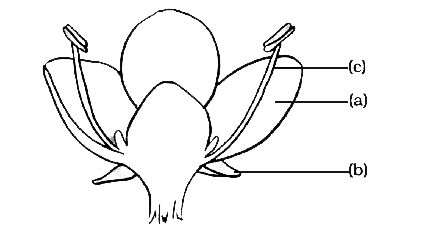Draw the following diagrams and label their parts:
(a) Stamen
(b) Pistil
Step-by-Step Solution:
Step 1: Drawing the Stamen
- Start by drawing a vertical line to represent the filament, which is the stalk of the stamen.
- At the top of the filament, draw a bilobed structure to represent the anther. This is where pollen grains are produced.
Step 2: Labeling the Stamen
- Label the vertical line as "Filament."
- Label the bilobed structure at the top as "Anther."
- Optionally, you can add a note that pollen grains are produced in the anther.
Step 3: Drawing the Pistil
- Begin by drawing a bulged structure at the bottom to represent the ovary. This is where ovules are located.
- Above the ovary, draw a narrow tube to represent the style, which connects the ovary to the stigma.
- At the top of the style, draw a flat structure to represent the stigma, where pollen grains land.
Step 4: Labeling the Pistil
- Label the bulged structure at the bottom as "Ovary."
- Label the narrow tube above the ovary as "Style."
- Label the flat structure at the top as "Stigma."
- Optionally, you can add a note that ovules are present in the ovary and are involved in fertilization.
Final Diagram:
- You should now have two diagrams: one for the stamen with its parts labeled (Filament and Anther) and one for the pistil with its parts labeled (Ovary, Style, and Stigma).
---
- Start by drawing a vertical line to represent the filament, which is the stalk of the stamen.
- At the top of the filament, draw a bilobed structure to represent the anther. This is where pollen grains are produced.
- Label the vertical line as "Filament."
- Label the bilobed structure at the top as "Anther."
- Optionally, you can add a note that pollen grains are produced in the anther.
- Begin by drawing a bulged structure at the bottom to represent the ovary. This is where ovules are located.
- Above the ovary, draw a narrow tube to represent the style, which connects the ovary to the stigma.
- At the top of the style, draw a flat structure to represent the stigma, where pollen grains land.
- Label the bulged structure at the bottom as "Ovary."
- Label the narrow tube above the ovary as "Style."
- Label the flat structure at the top as "Stigma."
- Optionally, you can add a note that ovules are present in the ovary and are involved in fertilization.
- You should now have two diagrams: one for the stamen with its parts labeled (Filament and Anther) and one for the pistil with its parts labeled (Ovary, Style, and Stigma).
Topper's Solved these Questions
- BOOK - PEARSON IIT JEE FOUNDATIONCHAPTER - REPRODUCTION IN LOWER ORGANISMS AND PLANTSEXERCISE - MASTERING THE CONCEPTS (APPLICATION AND ANALYSIS)16videos
REPRODUCTION IN LOWER ORGANISMS AND PLANTS
- BOOK - PEARSON IIT JEE FOUNDATIONCHAPTER - REPRODUCTION IN LOWER ORGANISMS AND PLANTSEXERCISE - MASTERING THE CONCEPTS (ASSERTIONS AND REASONS)8videos
REPRODUCTION IN LOWER ORGANISMS AND PLANTS
- BOOK - PEARSON IIT JEE FOUNDATIONCHAPTER - REPRODUCTION IN LOWER ORGANISMS AND PLANTSEXERCISE - TEST YOUR CONCEPTS (SELECT THE CORRECT ALTERNATIVES)22videos
REPRODUCTION IN LOWER ORGANISMS AND PLANTS
- BOOK - PEARSON IIT JEE FOUNDATIONCHAPTER - REPRODUCTION IN HUMAN BEINGSEXERCISE - ASSESSMENT TESTS35videos
REPRODUCTION IN HUMAN BEINGS
Similar Questions
Knowledge Check
- Question 1 - Select One
In the following diagram label A and B
 AA-endosperm, B- scutellumBA-scutellum, B-endospermCA-endosperm, B-aleuroneDA-aleurone layer, B- scutellum
AA-endosperm, B- scutellumBA-scutellum, B-endospermCA-endosperm, B-aleuroneDA-aleurone layer, B- scutellum
Draw a neat diagram of female reproductive system in humans and label the part where:
(a) egg is produced
(b) fertilization occursView SolutionDraw a neat diagram of the structure of chromosome and label the parts : (a) Centromere (b) p-arm
View SolutionDraw a diagram of the microscopic structure of human sperm. Label the following parts in it and write their functions.
(a) Acrosome
(b) Nucleus
(c) Middle pieceView SolutionDraw a neal labelled diagram of plant cell and label its parts.
View SolutionDraw a labelled diagram of a neuron.
View SolutionDraw a labelled diagram of a neuron.
View SolutionDraw a labeled diagram of sperm.
View Solution



